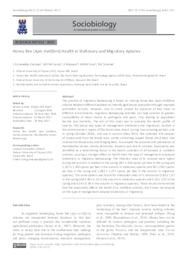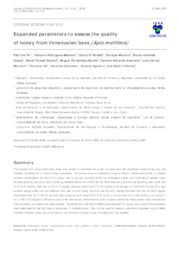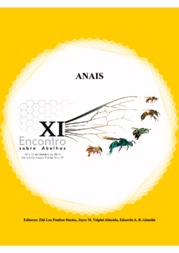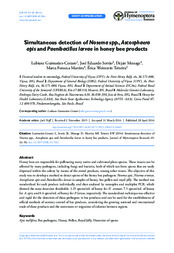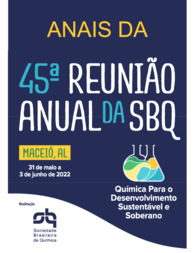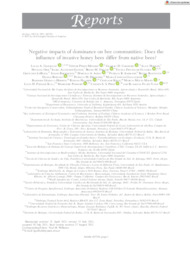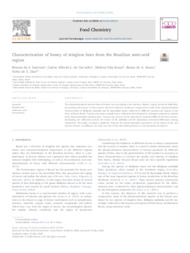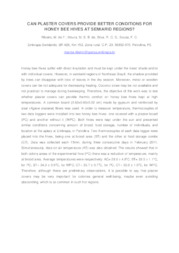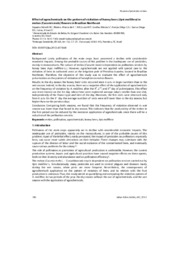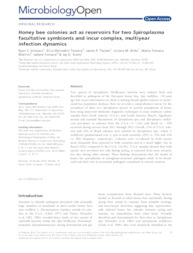Search Publications
Filter by:
| Author(s): CESTARO, L. G.; ALVES, M. L. T. M. F; MESSAGE, D.; SILVA, M. V. G. B.; TEIXEIRA, E. W. The practice of migratory beekeeping is based on moving honey bee (Apis mellifera) colonies between different locations to intensify agricultural production through improved pollination services. Howe... ... |
| Author(s): VIT, P.; RODRÍGUEZ-MALAVER, A.; ROUBIK, D. W.; MORENO, E.; SOUZA, B. de A.; SANCHO, M. T.; FERNÁNDEZ-MUIÑO, M.; ALMEIDA-ANACLETO, D.; MARCHINI, L. C.; GIL, F.; GONZÁLEZ, C.; AGUILERA, G.; NIEVES, B. Hive samples from seven Venezuelan states were studied to determine the quality of honeys from the naturalized tropical honey bee Apis mellifera, submitted for a national honey competition. The physic... ... |
| Author(s): RAMOS, J. D.; NUNES-SILVA, P.; WITTER, S.; BOTTON, M.; BLOCHTEIN, B.
|
| Author(s): GUIMARÃES-CESTARO, L.; SERRÃO, J. E.; MESSAGE, D.; MARTINS, M. F.; TEIXEIRA, É. W. Abstract Honey bees are responsible for pollinating many native and cultivated plant species. These insects can be affected by many pathogens, including fungi and bacteria, both of which can form spor... ... |
| Author(s): SANTISTEBAN, R. M.; F. NETO, J.; SILVA, E. M. S.; CORREIA, R. C.; CAMARA, C. A.; SILVA, T. M. S. The stingless bee Melipona mandacaia popularly known as mandacaia is endemic to the Caatinga biome, being found in the region of Vale do São Francisco. It is a very important bee for meliponiculture i... ... |
| Author(s): GARIBALDI, L. A; PÉREZ-MÉNDEZ, N.; CORDEIRO, G. D.; HUGHES, A.; ORR, M.; SANTOS, I. A. dos; FREITAS, B. M.; OLIVEIRA, F. F. de; LEBUHN, G.; BARTOMEUS, I.; AIZEN, M. A.; ANDRADE, P. B.; BLOCHTEIN, B.; BOSCOLO, D.; DRUMOND, P. M.; GAGLIANONE, M. C.; HERREN, B. G.; HALINSKI, R.; KRUG, C.; MAUES, M. M.; KIILL, L. H. P.; PINHEIRO, M.; PIRES, C. S. S.; VIANA, B. F. Invasive species can reach high abundances and dominate native environments. One of the most impressive examples of ecological invasions is the spread of the African sub-species of the honey bee throu... ... |
| Author(s): SANT'ANA, R. da S.; CARVALHO, C. A. L. de; ODA-SOUZA, M.; SOUZA, B. de A.; DIAS, F. de S. The physicochemical characteristics of honey vary according to bee species, climate, region, period of collection, processing and storage. In this context, this work aimed to perform a comparative stu... ... |
| Author(s): RIBEIRO, M. de F.; MOURA, M. S. B. de; SILVA, R. C. S.; SOUSA, F. C. The objective of this work was to test whether plaster covers can provide thermic comfort on honey bee hives kept at high temperatures. |
| Author(s): SIQUEIRA, K. M. M.; RIBEIRO, M. de F.; KIILL, L. H. P.; COELHO, M. S.; ARAUJO, D. C. S.; GAMA, D. R. S.; LIMA, JÚNIOR, I. O. Lately pollinators of the main crops have presented a decline with considerable economic impacts. Among the probable causes of this problem is the inadequate use of pesticides, mainly in monocultures.... ... |
| Author(s): SCHWARZ, R. S.; TEIXEIRA, E. W.; TAUBER, J. P.; BIRKE, J. M.; MARTINS, M. F.; FONSECA, I.; EVANS, J. D. Two species of Spiroplasma (Mollicutes) bacteria were isolated from and described as pathogens of the European honey bee, Apis mellifera, ?30 years ago but recent information on them is lacking despit... ... |
Observation
Some of Embrapa's publications are published as ePub files. To read them, use or download one of the following free software options to your computer or mobile device. Android: Google Play Books; IOS: iBooks; Windows and Linux: Calibre.
Access other publications
Access the Agricultural Research Database (BDPA) to consult Embrapa's full library collection and records.
Visit Embrapa Bookstore to purchase books and other publications sold by Embrapa.

